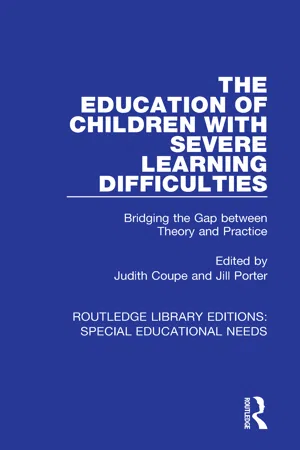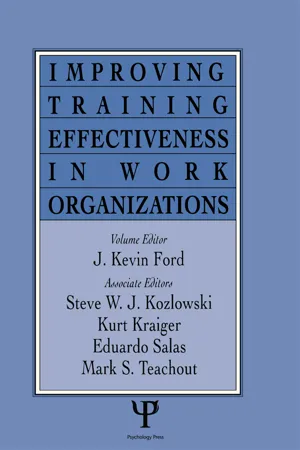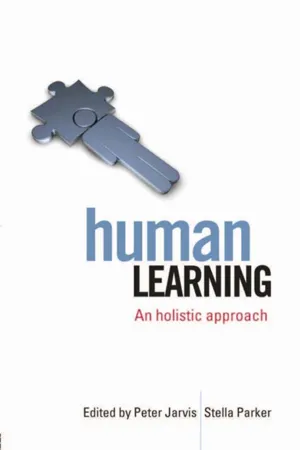Psychology
The Effects of Learning on Development
The effects of learning on development refer to the impact that acquiring new knowledge and skills has on an individual's cognitive, emotional, and social growth. This process shapes an individual's behavior, thinking patterns, and overall development, influencing their ability to adapt to new situations and challenges. Learning experiences can lead to changes in neural pathways and brain structures, contributing to cognitive and emotional development.
Written by Perlego with AI-assistance
Related key terms
7 Key excerpts on "The Effects of Learning on Development"
- eBook - ePub
Developmental Psychology for the Helping Professions
Evidence-Based Practice in Health and Social Care
- Brian Sheldon(Author)
- 2016(Publication Date)
- Palgrave Macmillan(Publisher)
3 The Influence of Learning on Development Behavior is a function of its consequences. —B.F. Skinner (1953)What Skinner says in this quote is somewhat true and, to say the least, was a useful corrective in its time to the then dominant brands of mentalistic psychology, which saw (somewhat magically) individuals largely as the instigators of behavioural reactions to the environment that had shaped them. Where else do thoughts, the supposed causes of behaviour, come from? The mind? What shapes that? Where is it to be found but in the brain? Is it a product or a cause? How could the mind be a cause if it is a non-material, non-weighable, non-dissectible ‘something’ with ghostly properties? You may be puzzled, but what are you puzzled with? Your brain has to be the logical answer (see Swaab, 2014; Ryle, 1949). But then, brains develop, they do not arrive with us fully formed. Therefore, how much of the development is inside-out and how much outside-in?Modern developmental psychology suggests the following:□ Human development largely unfolds from within. It unfolds easily if the environment supports the genetic ‘plan’, or slowly and falteringly if it does not (see Ridley, 2003).□ Yesterday’s environments are still inside us through conditioning and so are strong influencers of today’s behaviour, not only through memory (the most amazing of all psychological abilities, nothing less than an evolutionary adaptation to time) but via the stimuli to which we have been sensitized, the skills that we have (or have not) learned and their emotional/motivational accompaniments.Much of what makes us truly human, most of what makes us individuals rather than ‘clones’, much of what gives us a discernable personality – made up of semi-predictable patterns of behaviour, emotional reactions and thinking styles – is the product of learning. As we have seen, we get some help or hindrance from genetic endowment and are far from being tabulae rasae - eBook - ePub
- Julia Lawrence(Author)
- 2017(Publication Date)
- SAGE Publications Ltd(Publisher)
Task 2.1 invites you to start thinking about learning as a process that can occur in different domains or areas. For example, you have had to go through a learning process in order to gain qualifications thereby developing academically or cognitively; you have learnt how to work with other people thereby developing socially and emotionally; and you may also have learnt different physical skills thereby developing within the psychomotor domain. However, before we start to look at the specific domains of learning, it is important to develop an understanding of what we mean by learning in the context of this chapter.Learning can be defined as ‘the process whereby knowledge is created through the transformation of experience. Knowledge results from the combination of grasping and transforming experience’ (Kolb, 1984: 41). Sugden and Connell argue that learning occurs when a child ‘progresses from an absolute beginner to a performer of relative maturity’ (1979: 131). Delignieres et al. view learning as ‘a transitional process, from an initial response to more effective and/or efficient patterns’ (1998: 222). Learning therefore relates to the acquisition of knowledge, the storage of such knowledge and the ability to use knowledge in different situations or contexts. Furthermore, learning can be seen as progressive, suggesting that it occurs in stages. In viewing learning in this way, there is an acknowledgement of the individual differences we see among those learners with whom we work, and also that the speed of progression varies among different learners. If you look at the content of the National Curriculum (DfE, 2013), you will see that such a premise is reflected in the different aspects of knowledge, skills and understanding that pupils are expected to attain through the different key stages.Having defined learning, it becomes important to acknowledge the role the learner plays within the learning process. Katz argues that learners can adopt two roles within any learning process: they are either active and engage in ‘reasoning, the process of reflection, the development and analysis of ideas’ (2003: 16), which results in the development of a deeper level of understanding; or passive whereby the learner is instructed, resulting in a lack of opportunity to construct their own ideas. - eBook - ePub
- Vivienne Walkup(Author)
- 2013(Publication Date)
- Routledge(Publisher)
engagement with their environment. Learning is gained; it is not simply change over time. This distinguishes it from biological or developmental change such as cutting teeth or one’s hair turning grey. This chapter looks at ways in which psychology can inform our understanding of learning, and will look at some theoretical accounts of learning and consider their relevance within educational contexts.However, before we move on to these accounts, let us consider some of the bigger underlying questions about learning, such as why people learn and why we put ourselves through the process of education. There are a number of different explanations about learning including the view that it is a survival mechanism which allows humans to adapt to and survive within different changing environments. At a micro level this involves the genetic structure of the brain and ways in which brain cells and connections flourish or die depending upon the ways in which they are needed within specific environmental conditions. Looking at learning and the whole person, Piaget’s work initially with simple organisms (molluscs) which were able to adapt to different conditions caused him to ponder about human development. His subsequent studies which looked at the ways in which children’s thinking changed as they matured is rooted in this view but also acknowledges the importance of experience as an integral part of that development. Behaviourists explain learning as a response to stimuli and so place the emphasis much more squarely on the environment. They argue that actions which are rewarded are more likely to be repeated (learned) so that the individual develops a repertoire of learned behaviours. Humanists, such as Maslow (1968, 1970) and Rogers (1969), take a different view, suggesting that learning is something people do in order to satisfy their needs for self-fulfilment or self-actualisation. Many current explanations assume a combination of factors but current focus is upon ways in which humans process information (information-processing approaches - eBook - ePub
The Education of Children with Severe Learning Difficulties
Bridging the Gap between Theory and Practice
- Judith Coupe, Jill Porter(Authors)
- 2018(Publication Date)
- Routledge(Publisher)
PART TWO: FACTORS INFLUENCING LEARNING AND DEVELOPMENTThere is an almost arbitrary division of aspects of development. The first four chapters in this section highlight the interrelationship between the major developmental achievements of the child. These chapters are not intended as a simple, rationalised checklist of skills but as a way of perceiving the relationship between curriculum areas. In this vein Sarah Sandow in Chapter 4 draws together the meeting points of the ‘grand’ theories of development. She views the development of personality and socialisation within the context of the child’s overall development, and through the application of social learning theory shows how the personality of the child may have been shaped.Chapter 5 looks at the place of cognition in the curriculum and the interrelationship with action and perception. Nigel Carden traces the key cognitive tasks of the child using the Uzgiris and Hunt scales as a basis and goes on to take a positive view of the pre-operational skills, relating then to curriculum demands.The importance of cognitive development, and in particular means-end behaviour, is a theme which is continued by James Hogg in Chapter 6 . He takes an information processing approach to motor development, and in so doing illustrates how teaching may be fragmented and non-functional if the child is not viewed as a whole. In this chapter we clearly see the value of input from psychology to developing effective teaching strategies.Communication is a crucial factor in the child’s success within society. In Chapter 7 - J. Kevin Ford(Author)
- 2014(Publication Date)
- Psychology Press(Publisher)
Many companies have adopted a continuous learning philosophy as a means to facilitate employee development. One of the major tenets of a continuous learning philosophy is that employees at all levels of the company must actively pursue training and development activities. Continuous learning also requires employees to understand the relationship between their jobs and work units and the company’s mission. To advance research and practice of employee development practices, one needs to understand what types of activities are considered to be developmental, how development activities should be measured, how development activities facilitate learning, and what individual and organizational characteristics influence the amount and type of development activities that employees participate in. This chapter attempts to increase our understanding of these issues. The conceptual model that serves as an organizing framework for this chapter is presented in Fig. 7.1. The figure describes the process through which development activities result in the attainment of cognitive, affective, and skill-based learning outcomes. According to Kraiger, Ford, and Salas (1993), cognitive outcomes include verbal knowledge, how knowledge is organized, and the development and application of strategies for problem solving. Skill-based outcomes relate to the development of technical or motor skills. Affective outcomes include attitudes (such as self-awareness or values) and motivational outcomes (including motivational disposition, self-efficacy, and goal setting). Individual and organizational antecedents affect individuals’ decisions regarding the type and amount of participation in development activities. Each development activity affects one or more cognitive, skill-based, or affective learning outcomes- eBook - ePub
Forensic Psychiatry
Fundamentals and Clinical Practice
- Basant Puri, Ian H. Treasaden(Authors)
- 2017(Publication Date)
- CRC Press(Publisher)
8Developmental psychology
NATHALIA L. GJERSOE AND CATRIONA HAVARD Introduction Cognitive development Personality Social development Sexual development The child as witness Conclusion ReferencesINTRODUCTION
Developmental psychology is a discipline that encapsulates the full spectrum of psychological processes throughout the life span. Theories developed as part of this research have important implications not just for our understanding of children’s behavior and growth but also for how we conceptualize the human mind as a whole. Often there are processes so inextricably interwoven and sophisticated in adults that understanding them requires examination from their inception in the developing brain. This chapter focuses on the age range between infancy and late childhood and summarizes theories of children’s cognitive, personality, social, and sexual development, concluding with an outline of current opinion regarding children’s capacities as eyewitnesses.COGNITIVE DEVELOPMENT
Even newborns come into the world with a toolkit of basic sensory capacities and biases to attend to specific types of information. This stream of information forms the basis for mental representations—patterns of neuronal activity that refer to aspects of the external world. Developmental cognitive psychology examines mechanisms of change in mental representations throughout the life span. Examining cognitive development in infants and young children requires its own set of methodologies distinct from those used to examine adults. Children have limited communication and -comprehension abilities, disorganized or slow motor responses, and are easily distracted. Traditionally, research into cognitive development utilized naturalistic observation of children’s behavior at different ages and manipulated situations to determine if children’s responses changed in a reliable manner from age to age. This work has revealed a host of cognitive capabilities that all typically developing children seem to attain within a very similar time period—referred to as cognitive milestones - eBook - ePub
Human Learning
An Holistic Approach
- Peter Jarvis, Stella Parker(Authors)
- 2006(Publication Date)
- Routledge(Publisher)
Many learning theories deal only with one of these processes, which of course does not mean that they are wrong or worthless, as both processes can be studied separately. However, it does mean that they do not cover the whole field of learning. This may, for instance, be said of traditional behaviourist and cognitive learning theories focusing only on the internal psychological process. It can equally be said of certain modern social learning theories which – sometimes in explicit opposition to this – draw attention to the external interaction process alone. (Here I am referring to types of approach such as social constructionism (Gergen 1991, 1994) and the concept of situated learning (Lave and Wenger 1991).)However, it seems evident to me that both processes must be actively involved if any learning is to take place.The three dimensions of learning
In my model construction of the field of learning, I start by depicting the external interaction process as a vertical double arrow between the environ- ment, which is the general basis and therefore placed at the bottom, and the individual, who is the specific learner and therefore placed at the top.Next I add the psychological acquisition process as another double arrow. It is an internal process of the learner and must therefore be placed at the top pole of the interaction process. Further, it is a process of integrated interplay between two equal psychological functions involved in any learning, namely the function of cognition, dealing with the learning content, and the emotional or psychodynamic function, providing the neces- sary mental energy of the process. Thus, the double arrow of the acquisition process is placed horizontally at the top of the interaction process and between the poles of cognition and emotion: see Figure 6.1.As can be seen, the two double arrows can now span out a triangular field between three angles. These three angles depict three spheres or dimensions, and it is the core claim of the understanding that all learning will always involve these three dimensions.
Learn about this page
Index pages curate the most relevant extracts from our library of academic textbooks. They’ve been created using an in-house natural language model (NLM), each adding context and meaning to key research topics.






